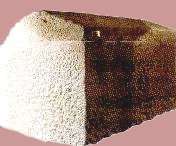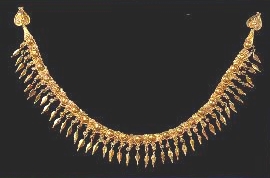|
The so-called Tomb of the Carian Princess, discovered in 1989 during construction work carried out just northeast of Bodrum, ancient Halicarnassos, was a chamber tomb containing a sarcophagus in which was the skeleton of a female about 40 years of age. The woman had been buried in a richly decorated garment sewn with gold appliques of a variety of shapes and designs, including astragals, rosettes, myrtIe flowers, triangles, hemispheres and tubes, and blue glass appliques in the form of astragals and barley-corns. Her jewellery included two necklaces; one of these was a short strap necklace with beech-nut pendants, the other a longer necklace with floral beads and plain beads from which were suspended seed-like pendants. Her gold stud earrings were spool- like, with concentric circles on each face. She wore a total of three gold rings, one with a comelian scarab engraved with a woman's head, one with a scaraboid of chalcedony engraved with the figure of a Persian leaning on his spear, and the third with an oval boxbezel. Her gold bracelets were penannular with antelope-head terminals. On her head was an elaborate gold myrtle wreath. A black-glazed oinochoe was found outside the sarcophagus.
|

Sarcophagus from the tomb of the Carian Princess
|

Gold neclace with seed shaped pendants
|
The jewellery and ornaments display both Greek and Eastern characteristics. Although a late 5th century date might also be considered, a 4th century date is generally accepted, and the tomb has been tentatively attributed to Ada, sister of Mausolos. The jewellery would be at variance with neither of the extremities of this time range.
|

Gold neclace with beechnut pendants
|







